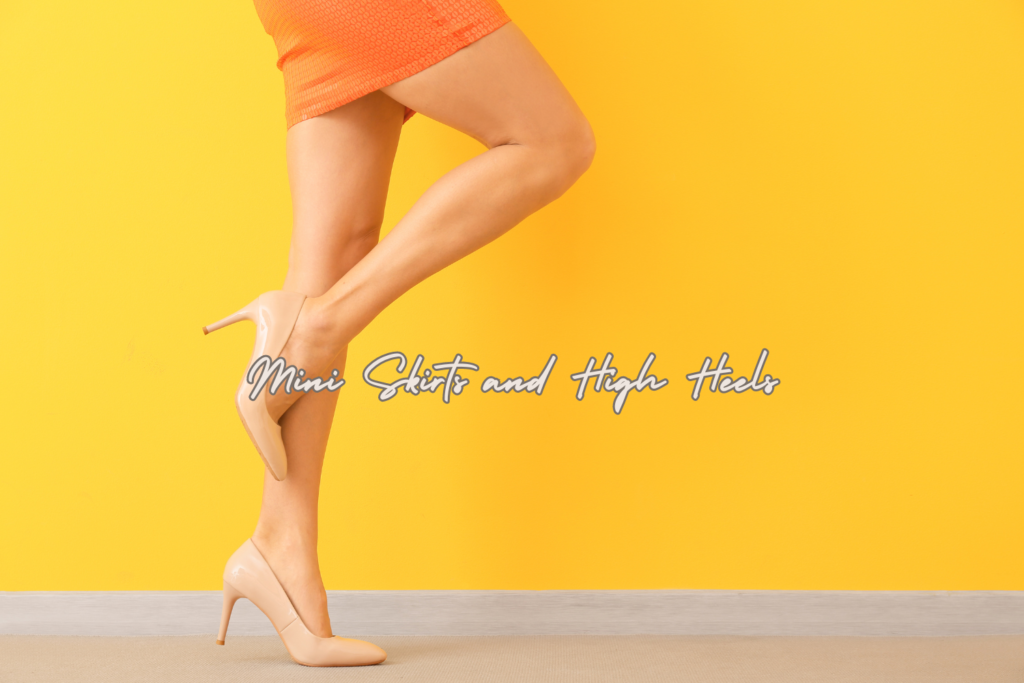Fashion is more than just clothing; it’s a form of self-expression, a way to communicate identity, confidence, and empowerment. Among the most iconic and controversial fashion choices are mini skirts and high heels. These bold items have sparked debates, defined eras, and become symbols of empowerment for many women. In this blog post, we’ll explore the history, cultural significance, and personal stories behind mini skirts and high heels, illustrating how these fashion staples have evolved from mere garments into powerful statements of individuality and strength.
The History of Mini Skirts and High Heels
The Mini Skirt Revolution
The mini skirt made its dramatic debut in the 1960s, a decade marked by social upheaval and a redefinition of cultural norms. British fashion designer Mary Quant is often credited with popularizing the mini skirt, which became a symbol of the youth-driven cultural revolution. For young women, wearing a mini skirt was a way to break free from the conservative dress codes of previous generations, embracing a new era of freedom and self-expression.
The mini skirt quickly became a fashion sensation, not just in London, where it first gained popularity, but across the globe. It was a visual representation of the feminist movement’s ideals, challenging traditional notions of modesty and redefining what it meant to dress femininely. The mini skirt was more than just a trend; it was a cultural shift, representing a new kind of woman who was bold, confident, and unapologetically herself.
High Heels: A History of Elevation and Empowerment
High heels have a much longer history, dating back centuries. Originally worn by men in the 10th century for practical reasons—such as keeping their feet secure in stirrups while riding—high heels eventually became a fashion statement among European aristocrats. By the 17th century, high heels had transitioned into women’s fashion, symbolizing status, elegance, and femininity.
In the 20th century, high heels became synonymous with glamour and sophistication, often associated with the allure of Hollywood starlets. Icons like Marilyn Monroe and Audrey Hepburn made high heels a must-have accessory, elevating them to a symbol of style and empowerment. For many women, high heels were more than just footwear; they were a way to assert their presence, adding height, confidence, and a touch of elegance to their overall look.
Cultural Significance and Controversy
Empowerment Through Fashion
For many women, wearing mini skirts and high heels is a form of empowerment. These items allow women to take control of their image, embracing their femininity while expressing their individuality. In a world where women’s appearances are often scrutinized and judged, the choice to wear something bold and attention-grabbing can be a powerful statement of self-confidence and autonomy.
Fashion journalist and critic Robin Givhan has argued that clothing can be a tool of empowerment, noting that “what we wear is both a reflection and a declaration of who we are.” Mini skirts and high heels, with their bold and often provocative nature, are a way for women to assert their identity and take pride in their appearance.
The Controversy
However, the cultural significance of mini skirts and high heels has not been without controversy. Both items have often been criticized for being overly sexualized or reinforcing traditional gender stereotypes. Some argue that these fashion choices can perpetuate the objectification of women, reducing their value to their physical appearance.
Despite this criticism, many women see these items as a means of reclaiming their bodies and their right to dress as they please. The key to this empowerment lies in choice—the decision to wear a mini skirt or high heels is a personal one, and for many, it’s a way to defy societal expectations and express their own unique style.
Personal Stories: Fashion as Empowerment
A Statement of Independence
For Emily, a 28-year-old marketing professional, wearing a mini skirt and high heels is a way to feel confident and assertive in the workplace. “I work in a male-dominated industry, and I used to feel pressured to dress down to fit in,” she says. “But over time, I realized that dressing the way I want—whether it’s a bold mini skirt or a pair of killer heels—makes me feel powerful. It’s my way of saying, ‘I belong here, and I’m not afraid to stand out.’”
Breaking Stereotypes
Monica, a 35-year-old entrepreneur, shares a similar sentiment. “Growing up, I was always told that dressing too ‘sexy’ would make people take me less seriously,” she recalls. “But as I’ve grown into my career, I’ve learned that what really matters is how I carry myself. Wearing a mini skirt or high heels doesn’t define my capabilities—it’s just one part of who I am. I’m breaking stereotypes by being both stylish and successful.”
A Celebration of Femininity
For Sarah, a 24-year-old artist, mini skirts and high heels are a celebration of femininity. “I love how these pieces make me feel—feminine, confident, and creative,” she says. “Fashion is art, and wearing something that makes me feel good is a form of self-expression. I don’t dress for anyone else; I dress for me, and that’s incredibly empowering.”
The Future of Mini Skirts and High Heels
As fashion continues to evolve, so too will the cultural significance of mini skirts and high heels. These items will likely remain a staple in many women’s wardrobes, serving as a reminder of the power of personal style and the freedom to dress as one chooses.
In a world where fashion is increasingly about individuality and self-expression, the future of mini skirts and high heels looks bright. These iconic pieces will continue to be worn by those who see them not just as clothing, but as symbols of empowerment, confidence, and the ongoing fight for gender equality.
Conclusion:
Mini skirts and high heels are more than just fashion items—they are powerful symbols of empowerment, self-expression, and the ongoing evolution of women’s roles in society. For many women, wearing these bold pieces is a way to assert their identity, embrace their femininity, and take control of their narrative. As we look to the future, it’s clear that the stories of mini skirts and high heels will continue to inspire and empower women around the world.
FAQs:
1. Are mini skirts and high heels considered empowering or controversial?
Mini skirts and high heels can be both empowering and controversial. They are often seen as symbols of self-expression and confidence, allowing women to embrace their femininity and personal style. However, they can also be viewed as overly sexualized or reinforcing stereotypes, depending on the cultural and social context. Ultimately, the interpretation varies based on individual perspectives.
2. How can I style a mini skirt for different occasions?
A mini skirt can be styled in various ways to suit different occasions:
- Casual: Pair with a graphic tee and sneakers.
- Work: Combine with a blouse, blazer, and low heels or flats (depending on the dress code).
- Evening: Wear with a fitted top, high heels, and statement jewelry.
- Layered: In colder weather, add tights or leggings, and pair with ankle boots and a cozy sweater.
3. Are high heels bad for your feet?
High heels can cause discomfort and long-term foot problems if worn frequently or for extended periods. Issues may include foot pain, bunions, and lower back strain. To minimize risks, choose heels with cushioned insoles, avoid excessively high heels, and give your feet a break by alternating with more comfortable shoes.
4. What should I consider when choosing a mini skirt or high heels?
When choosing a mini skirt, consider the length, fit, and occasion. Make sure the skirt is comfortable and allows for ease of movement. For high heels, focus on the heel height, arch support, and material. Look for a pair that provides both comfort and stability, especially if you’ll be wearing them for long periods.
5. How do mini skirts and high heels fit into the modern feminist movement?
Mini skirts and high heels are seen by many as symbols of female empowerment and choice. They represent the right to dress as one pleases, challenging traditional norms and expectations. However, some view them as problematic if they are worn due to societal pressure rather than personal preference. The modern feminist movement supports the idea that women should have the freedom to choose how they dress without judgment or imposed standards.

